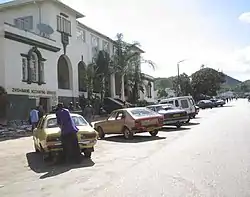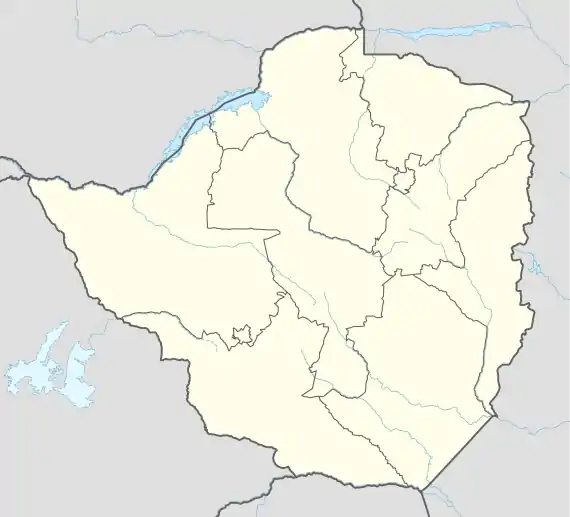Zvishavane
Zvishavane, formerly known as Shabani,[2] is a mining town in Midlands Province, Zimbabwe. Surrounded by low hills, it lies 97 kilometres (60 mi) west of Masvingo, on the main Bulawayo-Masvingo road. Other roads lead from Zvishavane to Gweru, 121 kilometres (75 mi) north, and Mberengwa, 27 kilometres (17 mi) south-west. It is also on direct rail links to Gweru and Beit Bridge which then link up with Harare and Bulawayo in Zimbabwe and to Maputo in Mozambique, and Pretoria in South Africa. It has a private airport serving the city.[3]
Zvishavane
Shabani | |
|---|---|
 Zvishavane | |
 Coat of arms | |
 Zvishavane | |
| Coordinates: 20°20′S 30°02′E | |
| Country | |
| Province | Midlands |
| District | Zvishavane |
| Population (2022 census)[1] | |
| • Total | 59,717 |
| Time zone | UTC+2 (CAT) |
| Climate | BSh |
Name
Zvishavane was formerly called Shabanie (used by the mine) or Shabani (used for the town). The name "Shabanie" has been said to be derived from "shavani", a Ndebele word meaning "finger millet", or "trading together".[4]
Zvishavane is a Shona name, which is said to be derived from "zvikomo zvishava", which means "red hills". The name means "reddish or 'reddened' hills", referring to the many surrounding low hills that are characterised by red soil.[4]
Zvishavane derives its name from its sister town Mashava. Mashava is a ChiShona word describing the hills in that place as reddish. The name Mashava formerly Mashaba origins is stated in the Rhodesian Lore and Legend: SOUTHERN RHODESIA PLACE NAMES published by The Chief Information Officer,
Information Services
Branch.
Division of Native Affairs,
Salisbury September, 1960[5]
| Shona word | English meaning | Explanation |
|---|---|---|
| Shava | Reddish | Shava is the Shona name of an Eland derived from the colour of the animal. |
| Chishava | Something reddish | it is a description of a single thing reddish in colour. |
| Mashava | Reddish | it describes particular reddish things. Here it describes reddish hills. |
| Zvishava | reddish things | it describes many things reddish in colour. |
| Zvishavane | semi reddish | it describes things not as reddish as the earlier. Here it describes the many surrounding low hills that are characterised by lighter red soil than those hills in Mashava |
Some claim that the name Shabanie derives from the isiNdebele Shavani which means "finger millet", or "trading together.[6] This is very unlikely for the matter that the English pronounced it as Shabanie.
- "va" in ChiShona is pronounced as the isiNdebele "ba".
- The word baba in isiNdebele rhymes with Vava in ChiShona and they are pronounced the same.
However the isiNdebele syllable va rhymes with vha in ChiShona.
- If Shavani was an isiNdebele word the ChiShona would have pronounced it as Shavhani. The English men would pronounce it as Sharvanie not Shabanie.
- If Shavani was a ChiShona word the isiNdebele would pronounce it Shabani, and so the English would pronounce it as Shabanie.
For this fact Shabanie derives from the ChiShona word Shavane or Shavani.
All the same finger millet colour is off-reddish, maybe tan in colour. That's Zviyo zvishavani or zvipfunde zvishavani (tan corn or tan millet) in ChiShona. Either way, the name derives from tan hills or tan coloured millet.

.jpg.webp)
History
The town developed as a residential centre for Shabani Mine, which started operations in 1916 to supply asbestos during the First World War. Growth was slow due to poor communications until the railway reached the town in 1928. Although the asbestos mine is the biggest producer of the mineral in Zvishavane, platinum, gold, beryl, chromite, iron ore at Buchwa and huge deposits of diamond at Murowa are also mined in the area.[3]
The surrounding area is dominated by cattle ranching, while peasant agriculture is practiced in the nearby communal lands of Mberengwa and Buchwa.[3]
The administration of Zvishavane has developed over the years to keep pace with its growth. A Village Management Board was set up in 1921 and replaced with a Town Management Board in 1930. It was granted municipal status in 1968.[3]
Population
The population of Zvishavane has grown substantially in recent decades due to a boom in mining activity. According to the 1982 Population Census, the town had a population of 26,758.[3] By 1992 this had risen to 32,984.[7] The population grew further to 35,128 in 2002[8] and 45,325 by 2012.[9]
Major Companies
- Mimosa Mining Company
- Shabanie Mine
- Sabi Gold Mine
- Murowa Diamonds
- Pote Holdings
- Midlands State University
- TK engineering
Transports
The village has a railway station on the Limpopo railway that connects it to Rutenga and Somabhula.[10]
Top Football Teams
Zvishavane is the home to 2 major football clubs which are:
https://tk-engineering-mechanical-engineer.business.site/#details==Notable residents==
- Alumni of Shabani Primary School include Philip Matyszak, Judith Todd, and George Zambellas.
- Gift Amuli, musician
- Mbizvo Chirasha, poet
- Judy Croome, novelist
- Emmerson Mnangagwa, President of Zimbabwe
- Cephas Msipa, governor of Midlands province
- Lewis Matutu, Member of the ZANU-PF central committee, Deputy Secretary for Youth Affairs, Philanthropist, Entrepreneur.
- Elliot Mujaji, Paralympics gold medalist
- Clement Chimuti, Agrobusiness Entrepreneur of the year and renowned golfer, 2015, 2016, 2017
- Tafadzwa Mawarire, Athlete and former African and National motocross champion, Entrepreneur, Mechanical Engineering Technician
- Garfield Todd- founder of Dadaya mission and school, missionary and Prime Minister of Southern Rhodesia
- Judith Todd- author and journalist
Tafadzwa Kuhwaura, Mechanical Engineer and Milwright (https://tk-engineering-mechanical-engineer.business.site/#details)
References
- Citypopulation.de Population of cities & urban localities in Zimbabwe
- Historical Dictionary of Zimbabwe. Lanham, MD: Scarecrow Press, Inc. 2001. ISBN 0-8108-3471-5.
- Encyclopedia Zimbabwe (2nd ed.). Worcester: Arlington Business Corporation. 1989. ISBN 0-9514505-0-6.
- "Zvishavane town profile". Sunday News. Zimbabwe. 22 November 2015.
- Lore and Legend: SOUTHERN RHODESIA PLACE NAMES: | A village and neighbourhood where many of the hills are reddish in colour. The name is derived from ChiShona mavu mashava (red soils), only the word mashava (red) having been retained in a slightly corrupted form. Another explanation is that the BaVenda, during their trek diagonally across Southern Rhodesia, used these hills as a beacon from the Selukwe range (Selukwe derives from the Venda word Chirugwe – " a stone pig pen". They said – "we must make for there – the Red Hills" – Makomo Mashaba. Mashaba as a name persisted. rhodesianheritage.blogspot|Retrieved 2 March 2016
- Isibindi Colourful Place Names of RhodesiaShabani rhodesia.me.uk|Retrieved 3 March 2016
- Africa South of the Sahara 2004. Psychology Press. 2003. p. 1239. ISBN 978-1-85743-183-4.
- "Zimbabwe - Population Census 2002". Central Statistical Office (CSO) – Government of Zimbabwe. p. 22. Retrieved 1 November 2016.
- "Census 2012 – Preliminary Report" (PDF). Zimbabwe National Statistics Agency. p. 97. Retrieved 1 November 2016.
- Network System: System Map. National Railways Of Zimbabwe. 2017.